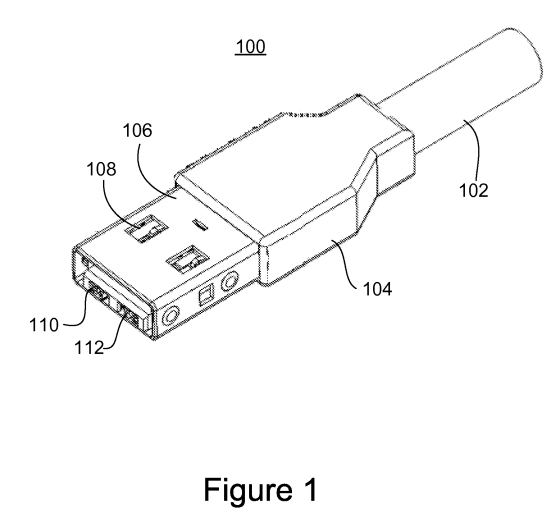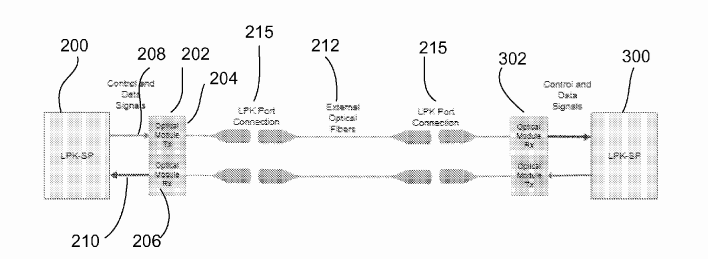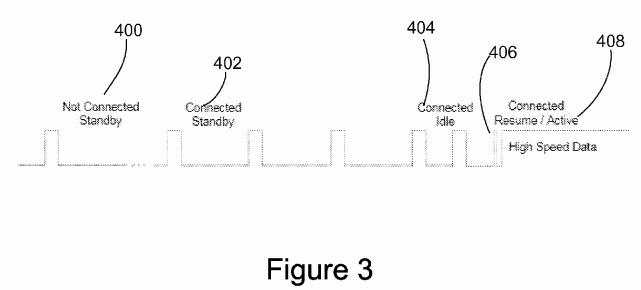PatentTips - Power management implementation in an optical link
BACKGROUND INFORMATION
Embodiments of the present invention are directed to optical links and, more particularly, to optical links which may save power when the optical link is unplugged and maintain eye safety standards.
Most optical links to date are used in the telecom and datacom industries, where optical modules tend to be connected during installation, and stay connected for the life of the equipment. These connections stay active as long as the link is connected, never switching off once started.
Optical links to be used in a consumer application may have different requirements, as the links are used dynamically, with devices being plugged and unplugged from the systems. In this case, it is desirable to save power when a port is not being used, insure that the port meets eye safety standards when the fiber is not connected, and that the port is able to robustly and reliably detect connections as they occur.
DETAILED DESCRIPTION
Meeting the simultaneous requirements of low power during idle times, eye safety, and robust connection detection requires the implementation of a power management scheme for the optical link.
Referring now to FIG. 1 there is shown an example of a universal serial bus (USB) device with additional optical capabilities for achieving even greater bandwidths. The USB device 100 has been referred to as the so-called Light Peak (LPK) optical USB. As shown, a cable 102 may join with a plastic housing 104. A plug head 106 may include openings 108 in the head 106 used to lock the connector in place when plugged into a corresponding female connector. Optical ports 110 and 112 may be housed in the head 106 to provide optical capabilities. Optical port 110 may for example be to connect to an optical transmitter (Tx) module and optical port 112 may connect to an optical receiver (Rx) module.

Referring to FIG. 2, there is shown a dual simplex optical link according to one embodiment of the present invention. In the Light Peak implementation, the components involved comprise a Light Peak Switch Port (LPK-SP) 200 and a Light Peak Optical Module (LPK-OM) 202. The LPK-OM 202 may comprise an optical transmit (Tx) module 204 and an optical receiver (Rx) module 206. Control and data signals 208 and 210 between the LPK-SP 200 and the LPK-OM 202 select the various power states of the module 202 and directly control the on/off conditions of the laser transmitter 204.

The optical receiver 206 may also be placed in the various power states, and then uses the received optical signals to indicate link states to the receiving portion of the LPK-SP 200. A complete optical link may comprise a LPK-SP 200 and LPK-OM 202 on one side, an optical fiber connection 212, and another LPK-OM 302and LPK-SP 300 on the other side. Each link is dual-simplex, with each side having a transmit channel connected to the opposite side receive channel. A separate fiber may be used for each direction, with both fibers 212 contained in the same optical cable.
Future implementations may combine the LPK-SP 200 and LPK-OM 202 into a more integrated unit, where the control and data Signals 208 become internal to the design. However, the power management functionality and states being used to control the optics would still exist.
Another option may be the integration of the LPK-OM 202 into a mechanical connector eliminating the fiber jumper from the LPK-OM 202 to the LPK Port Connection 215, and building the system side of the port connection directly into the mechanical connector. This scheme also would not alter the power management functionality between the LPK-SP 200 and the LPK-OM 202; it only changes the physical connection of the LPK-OM optical interface.
Future implementations may also include additional high speed signals, implemented as additional fibers and/or additional wavelengths of light sharing a single fiber or multiple fibers. Power management functionality would also be required for these implementations. In fact, the power management may become more critical in meeting eye safety criteria, as the additional optical signals may increase the optical power being carried by a connection.
When an optical port has no connection, it is desirable to save as much power as possible, and it is desired to meet eye safety standards. This is achieved by placing the optical module into a very low power Standby state, where the transmit laser 204 is disabled most of the time. The transmit stage 204 consumes almost no power while the laser is disabled. At the same time, the receive stage 206 has minimal functionality, where it only needs to detect the presence of low speed optical pulses (LSOP) and signal these pulses to the LPK-SP 200.
In order to actually detect a connection, the transmit stage 204 is pulsed on periodically, with a very low duty cycle, low speed pulse. The pulse represents below a 0.25% duty in one embodiment. This saves a significant amount of power for transmit stage 204 and easily meets the eye safety standards for an open port. When a physical connection is made, by connecting optical fiber between the two sides of the link, the link partner receiver 302 would detect the low speed optical pulse (LSOP), and signal the reception to the LPK-SP 300. At this point, the LPK-SP 200 can begin the detection process.
For robust connection detection, including the avoidance of false connection detection, the LPK-SP 200 may use a number of LSOPs to be received before deciding that a connection exists. For example, three pulses in a row, with no missing pulses, may be used to indicate that a fiber is connected. Once the pulses have been detected, the LPK-SP 200 commands the LPK-OM 202 to transition to a higher power Idle state, where more functionality is enabled and where higher speed responses are possible. The connection uses a modified LSOP, with a somewhat higher duty cycle of about 1% to signal to the link partner that the Idle state has been activated. The LPK-SP 200 and LPK-OM 202 continue this signaling until both sides of the link are in the same state. That is, the LPK-SP 200 is both sending and receiving the modified LSOP.
Once both sides of the link are signaling the modified LSOP, the link is transitioned to the Active state, using a different LSOP signal called RESUME. While in the Active state, the optical link is fully functional, sending high speed data from each transmit stage to the link partner receive stage. This involves higher power consumption, as all high speed data circuits are operational, and the optical signal is being modulated with the high speed data. Since the optical fibers are now connected in the link, the eye safety standards allow a higher power optical signal to be transmitted, as the signal will not be exposed to an open port while the fiber is connected.
The above described connection signaling scheme is illustrated in FIG. 3. When the optical link is not connected 400 the optical link is in a standby state and disabled most of the time as shown pulsing at a duty cycle below 0.25% using very little power and easily meeting eye safety standards. Once connected the link goes into a connected standby state 402 and the transmitter pulses a number of pulses, for example three low speed optical pulses, in a row signaling the receiver on the other side that a connection has been made. The optical link then transitions to a higher power Connected Idle state 404, for example a 1% duty cycle pulses, where more functionality is enabled and where higher speed responses are possible. This enables detection of a shorter duration RESUME pulse 406 to transition to an Active state 408 wherein the optical link is fully functional, sending high speed data from each transmit stage to the link partner receive stage.

Once in the Active state 408, the link can transition back and forth between Active and Idle without the fiber being disconnected. This represents another opportunity to save power in cases where there is a pause in the data flow. Since the fibers stay connected, it is possible to quickly transition back and forth between the Active and Idle states, as needed. During extended Idle states, the transmit stages send another LSOP signal, call CONNECT, to indicate that the fibers are still connected and that the link is still enabled. Note that the transition between Active and Idle can be independent in each fiber direction, so one link partner could be sending high speed data to the corresponding receive stage, while that transmit stage is signaling only the CONNECT pulses in the opposite direction.
If the fibers are disconnected from an enabled link, either on purpose, or due to a fault, the receive stage will no longer be receiving any optical signal, and the LPK-OM 202 will signal this case to the LPK-SP 200. If the receive stage was in the Idle state, receiving only the CONNECT LSOP signals, these signals will also no longer be detected. This would be the indication that the link has been disconnected. At this point, the LPK-SP 200 will disable the transmit stage, to again comply with the eye safety standards, then the LPK-OM 204 back to the Standby state, where it will wait for another connection.
In the case of multiple fiber or multiple wavelength connections, the connection detection can be performed on one fiber or wavelength at a time in order to keep the eye safety classification as low as possible. Other signals would stay disabled until a connection is established through the primary control signals. The disconnect from an enabled link, either on purpose, or due to a fault, is performed on each fiber and wavelength independently and the link is fully disabled to comply with the eye safety standards. The multi channel connection is then placed in the Standby state, where it waits for another connection by sending LSOP on one fiber or wavelength at a time.
The LPK-OM 204 should maintain the eye safety limits even when faults occur that would cause the optical signals to exceed these limits. Circuitry exists to shut down the laser in any fault situation; open, hardware short, or software issue, that would cause a violation to the eye safety limits.
This power management scheme takes the best advantage of a dynamic connection environment, where ports may be connected and disconnected at any time, and where data flows may start and stop as needed by the applications using the high speed data links. Power consumption is optimized, eye safety standards are met, and robust connection detection is preserved.
As a side benefit, running the transmit lasers in a higher power mode after the fibers are connected allows a larger range of laser transmit power to be used than has been the case in traditional telecom or datacom connections. This enables higher production yields for the lasers, larger link margins with similar eye safety classifications, and lower costs for the optical modules. This benefit would not be possible without the power management scheme to keep laser power very low while the fibers are disconnected.
SRC=http://www.freepatentsonline.com/8712236.html
PatentTips - Power management implementation in an optical link的更多相关文章
- Power Management开发的一般流程
本文作为一个提纲挈领的介绍性文档,后面会以此展开,逐渐丰富. 开发流程 针对一个PM feature进行开发,设计模型是第一步.模型设计好之后,还要保留参数接口,可以基于这些参数针对特殊个体进行优化. ...
- Linux下Power Management开发总结
本文作为一个提纲挈领的介绍性文档,后面会以此展开,逐渐丰富. 1. 前言 在 <开发流程>中介绍了PM开发的一般流程,重点是好的模型.简单有效的接口参数.可量化的测试环境以及可独性强的输出 ...
- Zephyr的Power Management
1 关于Zephyr Zephyr是Linux基金会维护的微内核项目,来源于WindRiver向Zephyr捐赠的Rocket RTOS内核.主要用于开发针对物联网设备的实时操作系统. Zephyr操 ...
- System and Device power management.
Advanced Configuration and Power Management Interface(ACPI)是由Intel,Microsoft等厂家订的一套Spec,规范了OS,APP对于电 ...
- Power management in semiconductor memory system
A method for operating a memory module device. The method can include transferring a chip select, co ...
- Power Management of Hybrid DRAM/PRAM-Based Main Memory
0.ABSTRACT (1)non-volatile memory——low standby power DRAM——high performance and better active power ...
- Xen之初体验:XenMotion、 StorageMotion、Site Recovery、Power Management 各种新、高级功能免费
Xenserver 的新版本6.2现在已经全面开源,省掉了原有的序列号,也能免费体验曾经标题中的付费高级功能. 安装镜像:http://downloadns.citrix.com.edgesuite. ...
- Hackintosh Power Management
Also, be aware that hibernation (suspend to disk or S4 sleep) is not supported on hackintosh. You sh ...
- Device Drivers Should Not Do Power Management
有人对现有的电源管理提出了意见,认为驱动程序不应该做电源管理,paper地址在这里: http://www.ruf.rice.edu/~mobile/publications/xu2014apsys. ...
随机推荐
- sort与sorted的区别
描述 我们需要对List进行排序,Python提供了两个方法对给定的List L进行排序 : 方法1.用对List的成员函数sort进行排序 方法2.用内置函数sorte ...
- [Apple开发者帐户帮助]八、管理档案(2)创建临时配置文件(iOS,tvOS,watchOS)
创建临时配置文件以在设备上运行您的应用程序而无需Xcode.在开始之前,您需要一个App ID,一个分发证书和多个注册设备. 有关完整的临时配置文件工作流程,请转到Xcode帮助中的分发到已注册设备( ...
- 开源矿工README
点击加入 NTMiner官方QQ群: 863725136 开源矿工内置的所有内核均为原版,开源矿工永远不会额外增加矿工支出: 开源矿工永远开源: 开源矿工永远不会去破解国人开发的内核: 下载地址 阿里 ...
- jQuery里$.post请求,后台返回结果为“json”格式,前台解析错误问题记录
在JSP页面使用$.post请求后台返回json数据时,在最后 必须加上返回数据格式为json的才行.不然JSP页面解析会出错.
- Nginx一个实现负载均衡的强大web server
<转>nginx 这个轻量级.高性能的 web server 主要可以干两件事情: 〉直接作为http server(代替apache,对PHP需要FastCGI处理器支持): 〉另外一个 ...
- Git系列学习(1)-Git安装
一.概述 msysGit名字前面的四个字面来源于MSYS项目: MSYS项目来源于MinGW(Minimalist GNU for Windows,最简GNU工具集) 通过添加一个bash提供的she ...
- Laravel (5.5.33) 加载过程(二)
本次说明代码 /* |-------------------------------------------------------------------------- | Turn On The ...
- Java 开源博客 Solo 1.3.0 发布 - Docker 支持
Solo 1.3.0 正式发布了,感谢一直以来关注 B3log 开源的朋友! 可以通过一个命令启动(不需要安装数据库.部署容器),也可以通过 war 方式部署容器,连接 MySQL.这应该是史上最容易 ...
- Android 检查手机上是否安装了指定的软件(根据包名检测)
Android检查手机上是否安装了指定的软件(根据包名检测) /** * 检查手机上是否安装了指定的软件 * @param context * @param packageName * @return ...
- Java 中访问数据库的步骤?Statement 和PreparedStatement 之间的区别?
Java 中访问数据库的步骤?Statement 和PreparedStatement 之间的区别? Java 中访问数据库的步骤 1)注册驱动: 2)建立连接: 3)创建Statement: 4)执 ...
